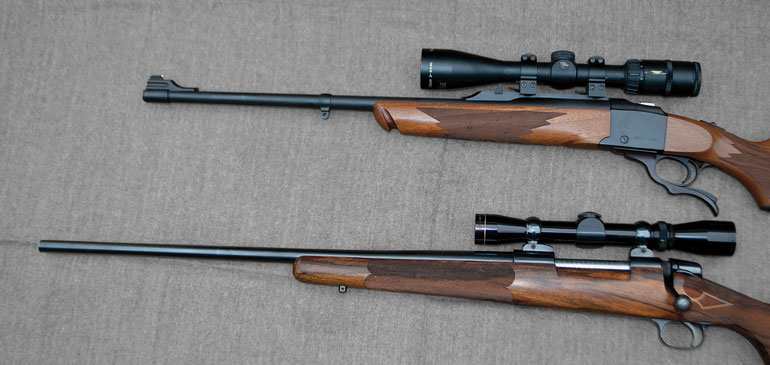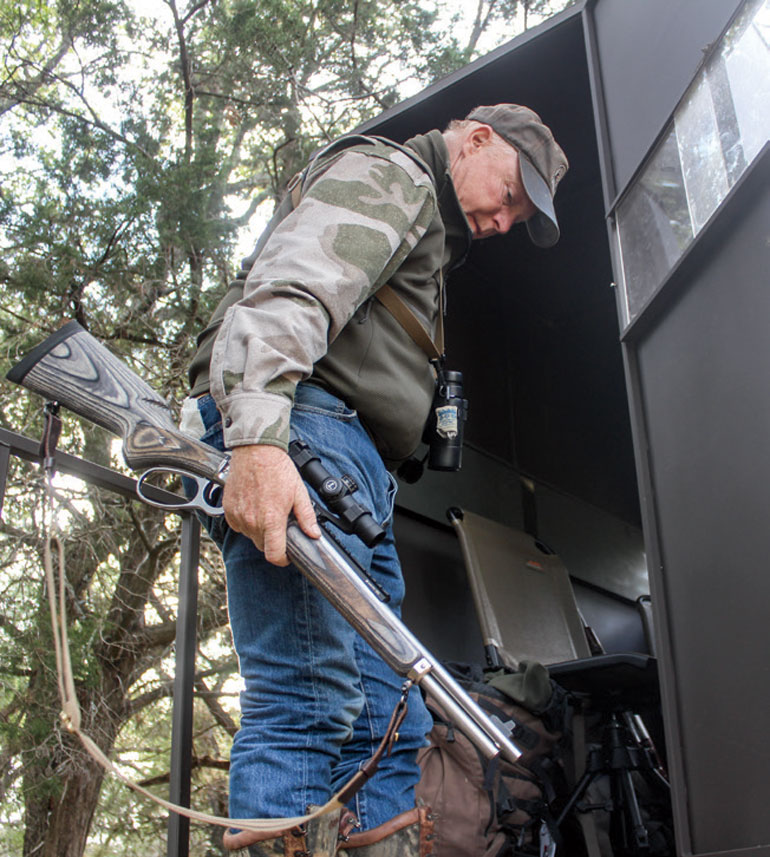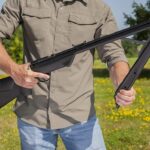
A few years before I retired from the Marine Corps, there was an initiative at headquarters calling for a wholesale replacement of the M16A2 rifle with the M4 carbine, which would have reduced the rifle’s 20-inch barrel to the M4’s 14.5-inch tube. At the time I was operations officer at I Marine Expeditionary Force, so it was really none of my business, but I went nuts. The obvious loss of velocity, and thus reduced energy and effective range, concerned me.
This was back in the Dark Ages, before the Marines had fully embraced optical sights, and I was equally concerned about loss of precision using battle sights with the M4’s much shorter sight radius. I did a lot of research and wrote a paper, and while it may never have been read, in the end our Marine riflemen kept the longer barrel.
Unless you’re going “retro” in a hunting rifle or participating in a competitive discipline requiring iron sights, it’s an optical sight world now, so the enhanced precision of longer sight radii on longer barrels isn’t significant. Therefore, choosing the ideal barrel length revolves around velocity (which influences trajectory and energy) handling characteristics and handiness. We must also consider action length and purpose.
Since 1934, “long arms” have been defined as having, at minimum, 16.1-inch barrels. There are no absolutes, but I figure “short” barrels today are 20 inches or less. “Standard” barrels are between, say, 21 and 24 inches. What I think of as “long” barrels are those longer than 24 inches, although barrels crowned longer than 26 inches are uncommon today.
Long barrels used to be much more fashionable. I have a Sharps .50-90 with a 30-inch barrel, not uncommon for the big 19th century single-shots. A century ago, Westley Richards had good success with its .318 and .425 Westley Richards rifles that wore “standard” barrels of 28 inches. There are also opposite examples. Before 1934, Winchester offered Trapper carbines in 14- and 15-inch barrels.
Personal taste counts for a lot, and while it may not be possible to suggest a “best” barrel length, let’s see if we can make some sense of this.
First, velocity. Longer barrels generate higher velocity because the propellant burns more completely. However, there are diminishing returns with extra-long barrels, depending on cartridge, caliber and propellant. It is often said we can expect a velocity change of about 20 to 25 fps per inch of barrel loss. This is approximate but not far off if we start with an “average” barrel of about 23 inches.
At this writing, the longest barrels I own for modern cartridges are 26 inches. I could take a 26-inch barrel, chronograph a load, and then hacksaw the barrel one inch at a time, recording velocity as I go. Uh, no. I’m not gonna ruin a good barrel. All we would learn is how much velocity was lost per inch with that cartridge, that load, in that barrel.
Case design matters. Short, fat cartridges are more efficient than long, slender cases, and they tend to produce more velocity in shorter barrels. The .308 Win. is more efficient than the .30-06. The short, fat 6.5mm Creedmoor case is more efficient than the 6.5×55. The short magnums are more efficient than the belted magnums they emulate.

Caliber relative to case also matters. Over-bore capacity means you are burning too much powder down a too-small hole. I’m among the last fans of the .264 Win. Mag. It is, and always was, over-bore capacity. So are the 7mm Shooting Times Westerner and 7mm Rem. Ultra Mag. This is not the kiss of death, but it means you need longer barrels to burn all the powder.
My .264 has a 26-inch barrel—and needs it. Similarly, the Weatherby AccuMark pictured in the lead photograph that I used on a caribou hunt was chambered in q6.5-300 Wby. Mag. This very fast 6.5mm is over-bore capacity and needs the long barrel.
Propellants vary widely in burning rates. In a perfect world, the propellant burns and the gases expand, accelerating the bullet until the end of the barrel is reached. At this point all propellant is burned, and the bullet exits at its maximum velocity. But how often does this really happen?
Now comes the wild card. Because of interior roughness or smoothness and variances in internal dimensions, seemingly identical barrels of like caliber and chamber vary considerably in the velocity they produce. There are “fast” barrels and “slow” barrels. (And, no, you cannot order an “extra-fast” barrel.)
Aside from efficiency of case design, it should be obvious that a short cartridge needs less barrel than a long cartridge. A .300 WSM is a half-inch shorter than a .300 Win. Mag. and 0.75 inch shorter than a .300 Wby. Mag. Barrels for shorter cartridges thus have a bit more rifling and less chamber, right? But now we’re splitting hairs.
Most factory ballistics are based on 24-inch barrels. So if you have a 22-inch barrel, you probably aren’t achieving published velocities. Don’t worry about it. Most non-magnum cartridges do fine with 22-inch barrels. Most magnum cartridges do well with 24-inch barrels. They may do better with 26-inch barrels, but is there any game animal or target that will recognize a difference of 100 fps?

I’ll be the first to admit I have never been into short barrels. However, velocity loss usually increases per inch with barrels much shorter than 22 inches. My wife has a gorgeous Dakota 7mm-08 with a 21-inch barrel. The 7mm-08 is efficient, and an inch means little. As long as you know your velocity—and your bullet’s ballistic coefficient—you can know your trajectory.
Longer barrels are not more accurate. If anything, it’s quite the opposite. Shorter, stiffer barrels tend to vibrate more consistently and are probably more accurate on average. However, quality of barrel and bedding are far more important, so we will leave accuracy out of this discussion.
Handling and handiness matter. I’m 5 feet 9 inches, Mr. Joe Average, and I’ve hunted very happily with barrels from 16 to 28 inches, a full foot difference in barrel length. Only rarely have I felt hampered by an extra-long barrel on a given rifle.
My wife and one of my daughters are short, and they find long barrels unwieldy. This becomes noticeable in brush, with a longer barrel sticking up above their heads, and on uneven ground with the stock swinging down to ankle level.
Many readers will recall I had an accurate 8mm Rem. Mag. with a 28-inch barrel. I also had an old Westley Richards .318 with a 28-inch barrel, which I used in Africa. I used that long-barreled 8mm all over the place. The concept behind it was to wring out as much velocity as possible—basically, to carry a ton of energy to 600 yards. For sure I never even shot at any game quite that far, but that was the idea.
I did quite a bit of elk hunting with the 8mm and used it on several mountain hunts. I eventually stopped using it because it was heavy, not because I felt hampered by the length. The weight wasn’t in the barrel but in the dense English wood and in the mercury reducer in the butt—partly to tame it a bit but also to keep the balance with that extra-long barrel.
Regardless of barrel length, I want a rifle to balance near the front of the action, so that it is neither butt- nor muzzle-heavy. About the hinge-pin seems perfect on a double, and somewhere near the forward receiver ring feels right for a bolt action. This balance is nice to carry and allows the gun to come up lively and on target.
Mind you, balance is not all about barrel length. It can be affected by barrel taper as well, but if you want a barrel long and thick, like a heavy varminter, it’s probably gonna be barrel-heavy.
I don’t recall ever feeling hampered by the long barrels on either that 8mm or the .318. However, I was always hunting in moderate cover, never in thick stuff or at close quarters. I can’t imagine hunting elephant in heavy cover with an original 28-inch-barrel .425—and yet hundreds of these rifles were purchased by African game departments.

One of the easiest ways to use a longer barrel is to use a shorter action. The turnbolt action is the longest of our action types. Lacking a repeating mechanism, the single-shot and double rifle have the shortest of all actions. My Ruger No. 1 Light Sporter with a 22-inch barrel is 4.5 inches shorter in overall length than a Balickie custom .270 with the same-length barrel.
This basically means I can have four extra inches of barrel without adding to rifle length. In fact, I do have this. My Ruger No. 1 Medium Sporter in .300 H&H with a 26-inch barrel has exactly the same overall length as that .270 Balickie.
I am not advocating single-shots here. I love ’em, but I also love bolt actions. However, if you want a longer barrel without adding gun length, a shorter action is one way to do it. Many lever actions are a bit shorter than bolt guns. A Savage 1899 .250-3000 with a 22-inch barrel is about 1.75 inches shorter than that .270. Semiautos vary depending on cartridge but are usually slightly shorter than bolt guns.
Obviously, short-action bolt guns are shorter than standard- or magnum-length actions. The straight-pull Blaser R8, which places the trigger assembly under the magazine instead of behind, is much shorter than conventional turnbolts. My Blaser R8 with a 22-inch barrel is three inches shorter overall than the Balickie .270. This Blaser with a 24-inch .300 barrel is three inches shorter than a Jarrett .300 with the same-length barrel. The Blaser could have extra-long barrels and gain more velocity without being longer than similarly chambered turnbolts, but these 24-inch barrels are fast enough for me.
The only real advantage I can think of to a long barrel is to gain more velocity. At one time, I thought I needed all the velocity I could get, but even an extreme velocity difference on the order of 200 fps due to barrel length doesn’t make a significant difference in the field.
However, as a hunter I want downrange energy, especially on larger game. Not necessarily all I can get, but enough. So I probably won’t go sheep hunting with a short-barreled rifle. And why should I? Up in the mountains gun weight is always a concern, but gun length means little.
On the other hand, there are situations where shorter barrels, and shorter rifles, offer significant advantages. The pre ’64 Winchester Model 70 .375 had a 25-inch barrel. Mine was a left-hand conversion, and I used it a lot—enough to burn out one barrel. With a full-length action and that barrel, I never thought of it as unwieldy, but it was long.
On my first bongo hunt in 1996, I had one chance in three weeks. On the 18th day, after tracking for several hours, I had a quick glimpse of a red animal moving in thick stuff. Maybe there was a shot, maybe not, but I couldn’t get the rifle up and the split-second passed.
I’ve relived that moment ever since. Maybe, just maybe, with a shorter barrel, I could have taken the shot.
Most problems I’ve had with long barrels are in blinds. Box blinds, often with low roofs, are endemic in Texas, but they’re encountered all over the place. When an animal appears, the trick is to get the rifle to the correct window quietly.
This is difficult enough without banging the barrel on the ceiling, wall or window frame. The longer the barrel, the more difficult. I’ve used 26-inch-barreled bolt actions in many blinds, and I felt like a contortionist trying to bring the rifle to bear silently—and I wasn’t always successful.
Hunting with hounds is another situation where short barrels win. You are always scrambling through thick stuff. When you reach the dogs, the shot will be close, so velocity doesn’t matter much. Houndsmen invariably use short carbines. Short-barreled lever-action .30-30s are favorites, and some hound hunters still use the Remington Model 600 in .350 Rem. Mag.
The only rifles I have with really short barrels are a Winchester M94 Trapper .30-30 with a 16.1-inch barrel and a Marlin 1894 .44 Mag. with a 16.5-inch barrel. Both rifles are handy in thick brush and awesome in tight-quarter blinds. However, I use them only in situations where shots much beyond 100 yards are unlikely.
I also have rifles with 20-inch barrels, ARs and lever-action carbines. They are also handy, but I never think of them as lacking in capability.
At the other end of the spectrum, I own bolt-action rifles and single-shots with 26-inch barrels. The single-shots are amazingly short and handy for that much barrel. The bolt actions are neither; they are long rifles with long barrels, chambered to over-bore capacity cartridges that make good use of the longer tubes. These include my .264 Win. Mag., 6.5-300 Wby. Mag., .300 Wby. Mag. and a Lazzeroni 7.82 Warbird.
Today most of my rifles wear either 22- or 24-inch tubes, the two most common barrel lengths in current sporting rifles. My 22-inch barrels are invariably chambered to “standard” cartridges: 6.5mm Creedmoor, .270, .308 and .30-06.
The 24-inch barrels are mostly magnums (belted and unbelted) or large calibers. These barrel lengths are not written in stone, and there are anomalies: The mate to that 21-inch-barreled 7mm-08 I mentioned is a .257 Roberts that wears a 23-inch barrel. My CZ .375 H&H has a 25-inch barrel.
For most of us, for most purposes, the range probably runs from 20 to 26 inches, depending on action, cartridge, intended use and how much emphasis you put on handiness. A couple inches of barrel either way doesn’t mean much, but give it serious thought before you go extra-short or extra-long.














































![Air gun 101: The differences between .177 & .22 – Which jobs they do best ? [Infographic]](https://airgunmaniac.com/wp-content/uploads/2024/11/1773-150x150.jpeg)
